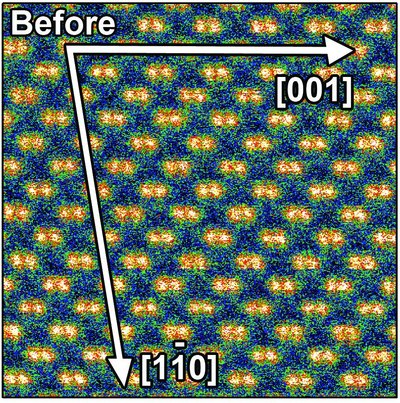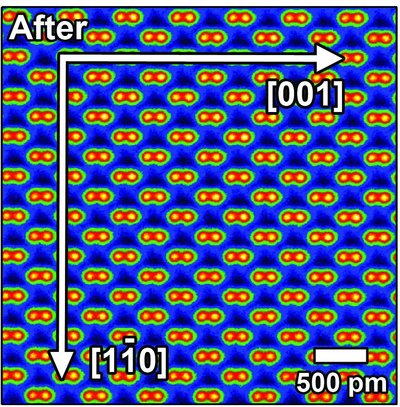Removing distortion from atomic-scale images
Microscopy researchers at North Carolina State University have developed a technique that eliminates the distortion encountered when capturing images at the atomic scale. Their method will be reported in the March issue of Ultramicroscopy.
Scanning transmission electron microscopes (TEMs) can capture images of a material’s individual atoms. To take those images, scientists have to allow a probe to scan across the sample area, which has an area of less than 25 nm2. The scan can take tens of seconds.
The sample rests on a support rod and, while the scanning takes place, the rod expands or contracts due to subtle changes in ambient temperature. The rod’s expansion or contraction is imperceptible to the naked eye, but because the sample area is measured in nanometres the rod’s movement causes the sample material to shift slightly. This so-called ‘drift’ can cause the resulting scanning TEM images to be significantly distorted, and is a problem that was thought virtually impossible to prevent.
According to Dr James LeBeau, an assistant professor of materials science and engineering at the university and senior author of the study paper, “Our approach effectively eliminates the effect of drift on scanning TEM images.” They have dubbed the technique ‘RevSTEM’ - revolving scanning transmission electron microscopy.


The researchers program the microscope to rotate the direction in which it scans the sample. For example, it might first take an image scanning from left to right, then take one scanning from top to bottom, then right to left, then bottom to top. Each scanning direction captures the distortion caused by drift from a different vantage point.
They then plug those images into a program they developed that measures the features in each image and uses that data to determine the precise direction and extent of drift within the sample. Once the drift is quantified, the images can be adjusted to remove the distortion caused by the drift.
The resulting images accurately represent the actual structure of the sample and give scientists new capabilities to understand bonding between atoms. This is particularly significant, said Dr LeBeau, as it eliminates the need for a reference material - previously required so scientists could tell how the image has been distorted.
“That means we can now look at completely unknown samples and discover their crystalline structures,” he said, “which is an important step in helping us control a material’s physical properties.”
There is currently a patent pending on the technique.
Revealed: the complex composition of Sydney's beach blobs
Scientists have made significant progress in understanding the composition of the mysterious...
Sensitive gas measurement with a new spectroscopy technique
'Free-form dual-comb spectroscopy' offers a faster, more flexible and more sensitive way...
The chemistry of Sydney's 'tar balls' explained
The arrival of hundreds of tar balls — dark, spherical, sticky blobs formed from weathered...




